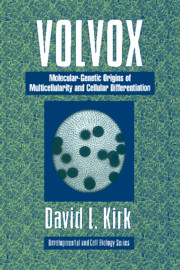 Volvox
Volvox Book contents
- Frontmatter
- Contents
- Preface
- Prologue
- 1 Introduction
- 2 The Volvocales: Many Multicellular Innovations
- 3 Ecological Factors Fostering the Evolution of Volvox
- 4 Cytological Features Fostering the Evolution of Volvox
- 5 Volvox carteri: A Rosetta Stone for Deciphering the Origins of Cytodifferentiation
- 6 Mutational Analysis of the V. carteri Developmental Program
- 7 Molecular Analysis of V. carteri Genes and Development
- Epilogue
- References
- Index
6 - Mutational Analysis of the V. carteri Developmental Program
Published online by Cambridge University Press: 16 December 2009
- Frontmatter
- Contents
- Preface
- Prologue
- 1 Introduction
- 2 The Volvocales: Many Multicellular Innovations
- 3 Ecological Factors Fostering the Evolution of Volvox
- 4 Cytological Features Fostering the Evolution of Volvox
- 5 Volvox carteri: A Rosetta Stone for Deciphering the Origins of Cytodifferentiation
- 6 Mutational Analysis of the V. carteri Developmental Program
- 7 Molecular Analysis of V. carteri Genes and Development
- Epilogue
- References
- Index
Summary
… mutants involving the time of differentiation, the pattern of differentiation, and the nature of the differentiated reproductive cells indicate embryogenesis in Volvox carteri f. nagariensis is under the control of a number of genetic loci. …
The somatic cells of V. carteri show a characteristic … loss of ability to grow and divide. … A mutant has been isolated in which the somatic cells do not lose this ability. This mutant … may provide us with interesting material to study controls by which such processes of cell growth and multiplication are regulated.
Starr (1970a)With those words summarizing his observations of several interesting spontaneous mutants of V. carteri, Richard Starr tried to direct the attention of those assembled for an annual meeting of the Society for Developmental Biology toward a promising new avenue for analyzing the genetic control of cell differentiation. But for some reason that was not an avenue destined to become quickly crowded with fellow travelers. Over the next quarter century, only nine laboratories would publish one or more studies involving the use of V. carteri mutants, and of those, only three would make any sustained efforts to use genetics as a tool for dissecting V. carteri development. Despite that lukewarm response to Starr's summons, his perception that V. carteri had substantial promise as a developmental genetic system was soon reinforced, principally through the efforts of one laboratory.
Robert Huskey, formerly a bacteriophage geneticist, was the first to join Starr in the exploration of V. carteri developmental genetics.
- Type
- Chapter
- Information
- VolvoxA Search for the Molecular and Genetic Origins of Multicellularity and Cellular Differentiation, pp. 218 - 257Publisher: Cambridge University PressPrint publication year: 1997


